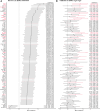Associations of Proteomics With Hypertension and Systolic Blood Pressure: KORA S4/F4/FF4 and KORA Age1/Age2 Cohort Studies
- PMID: 38445514
- PMCID: PMC11025610
- DOI: 10.1161/HYPERTENSIONAHA.123.22614
Associations of Proteomics With Hypertension and Systolic Blood Pressure: KORA S4/F4/FF4 and KORA Age1/Age2 Cohort Studies
Abstract
Background: Hypertension, a complex condition, is primarily defined based on blood pressure readings without involving its pathophysiological mechanisms. We aimed to identify biomarkers through a proteomic approach, thereby enhancing the future definition of hypertension with insights into its molecular mechanisms.
Methods: The discovery analysis included 1560 participants, aged 55 to 74 years at baseline, from the KORA (Cooperative Health Research in the Region of Augsburg) S4/F4/FF4 cohort study, with 3332 observations over a median of 13.4 years of follow-up. Generalized estimating equations were used to estimate the associations of 233 plasma proteins with hypertension and systolic blood pressure (SBP). For validation, proteins significantly associated with hypertension or SBP in the discovery analysis were validated in the KORA Age1/Age2 cohort study (1024 participants, 1810 observations). A 2-sample Mendelian randomization analysis was conducted to infer causalities of validated proteins with SBP.
Results: Discovery analysis identified 49 proteins associated with hypertension and 99 associated with SBP. Validation in the KORA Age1/Age2 study replicated 7 proteins associated with hypertension and 23 associated with SBP. Three proteins, NT-proBNP (N-terminal pro-B-type natriuretic peptide), KIM1 (kidney injury molecule 1), and OPG (osteoprotegerin), consistently showed positive associations with both outcomes. Five proteins demonstrated potential causal associations with SBP in Mendelian randomization analysis, including NT-proBNP and OPG.
Conclusions: We identified and validated 7 hypertension-associated and 23 SBP-associated proteins across 2 cohort studies. KIM1, NT-proBNP, and OPG demonstrated robust associations, and OPG was identified for the first time as associated with blood pressure. For NT-proBNP (protective) and OPG, causal associations with SBP were suggested.
Keywords: Mendelian randomization analysis; blood pressure; cohort studies; hypertension; proteomics.
Conflict of interest statement
Figures




Similar articles
-
Proteomic profiling of longitudinal changes in kidney function among middle-aged and older men and women: the KORA S4/F4/FF4 study.BMC Med. 2023 Jul 5;21(1):245. doi: 10.1186/s12916-023-02962-z. BMC Med. 2023. PMID: 37407978 Free PMC article.
-
Effect of Intensive Blood Pressure Control on Troponin and Natriuretic Peptide Levels: Findings From SPRINT.Circulation. 2023 Jan 24;147(4):310-323. doi: 10.1161/CIRCULATIONAHA.122.059960. Epub 2022 Dec 19. Circulation. 2023. PMID: 36533535
-
Proteomic profiling of low muscle and high fat mass: a machine learning approach in the KORA S4/FF4 study.J Cachexia Sarcopenia Muscle. 2021 Aug;12(4):1011-1023. doi: 10.1002/jcsm.12733. Epub 2021 Jun 20. J Cachexia Sarcopenia Muscle. 2021. PMID: 34151535 Free PMC article.
-
Associations of plasma proteomics with type 2 diabetes and related traits: results from the longitudinal KORA S4/F4/FF4 Study.Diabetologia. 2023 Sep;66(9):1655-1668. doi: 10.1007/s00125-023-05943-2. Epub 2023 Jun 13. Diabetologia. 2023. PMID: 37308750
-
Association of plasma proteomics with incident coronary heart disease in individuals with and without type 2 diabetes: results from the population-based KORA study.Cardiovasc Diabetol. 2024 Feb 3;23(1):53. doi: 10.1186/s12933-024-02143-z. Cardiovasc Diabetol. 2024. PMID: 38310303 Free PMC article.
References
-
- GBD 2015 Risk Factors Collaborators. Global, regional, and national comparative risk assessment of 79 behavioural, environmental and occupational, and metabolic risks or clusters of risks, 1990-2015: a systematic analysis for the Global Burden of Disease Study 2015. Lancet. 2016;388:1659–1724. doi: 10.1016/S0140-6736(16)31679-8 - PMC - PubMed
-
- Chalmers J, MacMahon S, Mancia G, Whitworth J, Beilin L, Hansson L, Neal B, Rodgers A, Ni Mhurchu C, Clark T. 1999 World Health Organization-International Society of Hypertension Guidelines for the management of hypertension. Guidelines sub-committee of the World Health Organization. Clin Exp Hypertens. 1999;21:1009–1060. doi: 10.3109/10641969909061028 - PubMed
-
- NCD Risk Factor Collaboration (NCD-RisC). Worldwide trends in hypertension prevalence and progress in treatment and control from 1990 to 2019: a pooled analysis of 1201 population-representative studies with 104 million participants. Lancet. 2021;398:957–980. doi: 10.1016/S0140-6736(21)01330-1 - PMC - PubMed
-
- Whelton Paul K, Carey Robert M, Aronow Wilbert S, Casey Donald E, Collins Karen J, Dennison Himmelfarb C, DePalma Sondra M, Gidding S, Jamerson Kenneth A, Jones Daniel W, et al. . 2017 ACC/AHA/AAPA/ABC/ACPM/AGS/APhA/ASH/ASPC/NMA/PCNA guideline for the prevention, detection, evaluation, and management of high blood pressure in adults. J Am Coll Cardiol. 2018;71:e127–e248. doi: 10.1016/j.jacc.2017.11.006 - PubMed
MeSH terms
Substances
LinkOut - more resources
Full Text Sources
Medical
Research Materials

